|
在很多方面,蓝牙是一种能够发送或接受两个不同的设备之间传输的数据。 Android平台包含了蓝牙框架,使设备以无线方式与其他蓝牙设备进行数据交换的支持。
Android提供蓝牙API来执行这些不同的操作。
-
扫描其他蓝牙设备
-
获取配对设备列表
-
连接到通过服务发现其他设备
Android提供BluetoothAdapter类蓝牙通信。通过调用创建的对象的静态方法getDefaultAdapter()。其语法如下给出。
private BluetoothAdapter BA;
BA = BluetoothAdapter.getDefaultAdapter(); |
为了使用设备的蓝牙,调用下列蓝牙ACTION_REQUEST_ENABLE的意图。其语法如下:
Intent turnOn = new Intent(BluetoothAdapter.ACTION_REQUEST_ENABLE);
startActivityForResult(turnOn, 0); |
除了这个常量,有提供其它的API,支持不同任务的其他常数。它们在下面列出。

启用了蓝牙功能之后,可以通过调用 getBondedDevices()方法来获取配对设备列表。它返回一组的蓝牙设备。其语法如下:
private Set<BluetoothDevice>pairedDevices;
pairedDevices = BA.getBondedDevices(); |
除了配对的设备,还有API,让更多蓝牙控制权等方法。它们在下面列出。
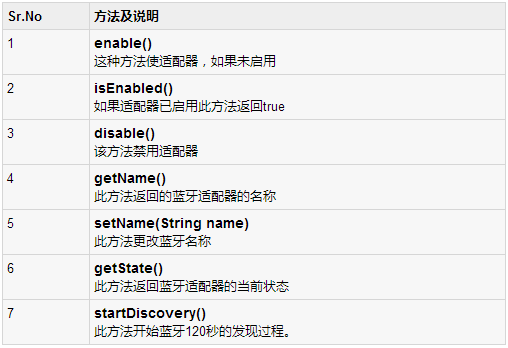
例子
这个例子提供了示范BluetoothAdapter类操纵蓝牙,并显示通过蓝牙配对设备列表。
为了试验这个例子,需要在实际设备上运行此程序
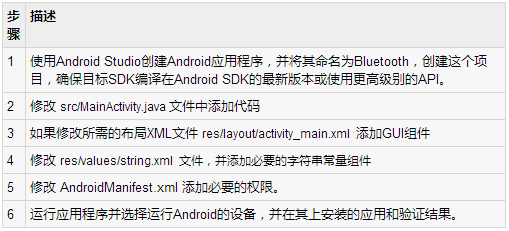
以下是?src/com.yiibai.bluetooth/MainActivity.java?文件的内容:
package com.example.bluetooth;
import java.util.ArrayList;
import java.util.List;
import java.util.Set;
import android.os.Bundle;
import android.app.Activity;
import android.bluetooth.BluetoothAdapter;
import android.bluetooth.BluetoothDevice;
import android.content.Intent;
import android.view.Menu;
import android.view.View;
import android.widget.ArrayAdapter;
import android.widget.Button;
import android.widget.ListAdapter;
import android.widget.ListView;
import android.widget.Toast;
public class MainActivity extends Activity {
private Button On,Off,Visible,list;
private BluetoothAdapter BA;
private Set<BluetoothDevice>pairedDevices;
private ListView lv;
@Override
protected void onCreate(Bundle savedInstanceState) {
super.onCreate(savedInstanceState);
setContentView(R.layout.activity_main);
On = (Button)findViewById(R.id.button1);
Off = (Button)findViewById(R.id.button2);
Visible = (Button)findViewById(R.id.button3);
list = (Button)findViewById(R.id.button4);
lv = (ListView)findViewById(R.id.listView1);
BA = BluetoothAdapter.getDefaultAdapter();
}
public void on(View view){
if (!BA.isEnabled()) {
Intent turnOn = new Intent(BluetoothAdapter.ACTION_REQUEST_ENABLE);
startActivityForResult(turnOn, 0);
Toast.makeText(getApplicationContext(),"Turned on"
,Toast.LENGTH_LONG).show();
}
else{
Toast.makeText(getApplicationContext(),"Already on",
Toast.LENGTH_LONG).show();
}
}
public void list(View view){
pairedDevices = BA.getBondedDevices();
ArrayList list = new ArrayList();
for(BluetoothDevice bt : pairedDevices)
list.add(bt.getName());
Toast.makeText(getApplicationContext(),"Showing Paired Devices",
Toast.LENGTH_SHORT).show();
final ArrayAdapter adapter = new ArrayAdapter
(this,android.R.layout.simple_list_item_1, list);
lv.setAdapter(adapter);
}
public void off(View view){
BA.disable();
Toast.makeText(getApplicationContext(),"Turned off" ,
Toast.LENGTH_LONG).show();
}
public void visible(View view){
Intent getVisible = new Intent(BluetoothAdapter.
ACTION_REQUEST_DISCOVERABLE);
startActivityForResult(getVisible, 0);
}
@Override
public boolean onCreateOptionsMenu(Menu menu) {
// Inflate the menu; this adds items to the action bar if it is present.
getMenuInflater().inflate(R.menu.main, menu);
return true;
}
} |
这里是?activity_main.xml?文件的内容:
<RelativeLayout xmlns:android="http://schemas.android.com/apk/res/android"
xmlns:tools="http://schemas.android.com/tools"
android:layout_width="match_parent"
android:layout_height="match_parent"
android:paddingBottom="@dimen/activity_vertical_margin"
android:paddingLeft="@dimen/activity_horizontal_margin"
android:paddingRight="@dimen/activity_horizontal_margin"
android:paddingTop="@dimen/activity_vertical_margin"
tools:context=".MainActivity" >
<ScrollView
android:id="@+id/scrollView1"
android:layout_width="wrap_content"
android:layout_height="wrap_content"
android:layout_alignParentBottom="true"
android:layout_alignParentLeft="true"
android:layout_alignParentRight="true"
android:layout_alignParentTop="true" >
<LinearLayout
android:layout_width="match_parent"
android:layout_height="match_parent"
android:orientation="vertical" >
<TextView
android:id="@+id/textView1"
android:layout_width="wrap_content"
android:layout_height="wrap_content"
android:text="@string/app_name"
android:textAppearance="?android:attr/textAppearanceLarge" />
<Button
android:id="@+id/button1"
android:layout_width="wrap_content"
android:layout_height="wrap_content"
android:onClick="on"
android:text="@string/on" />
<Button
android:id="@+id/button2"
android:layout_width="wrap_content"
android:layout_height="wrap_content"
android:onClick="visible"
android:text="@string/Visible" />
<Button
android:id="@+id/button3"
android:layout_width="wrap_content"
android:layout_height="wrap_content"
android:onClick="list"
android:text="@string/List" />
<Button
android:id="@+id/button4"
android:layout_width="wrap_content"
android:layout_height="wrap_content"
android:onClick="off"
android:text="@string/off" />
<ListView
android:id="@+id/listView1"
android:layout_width="match_parent"
android:layout_height="wrap_content"
android:visibility="visible" >
</ListView>
</LinearLayout>
</ScrollView>
</RelativeLayout> |
这里是?Strings.xml?文件的内容:
<?xml version="1.0" encoding="utf-8"?>
<resources>
<string name="app_name">Bluetooth</string>
<string name="action_settings">Settings</string>
<string name="hello_world">Hello world!</string>
<string name="on">Turn On</string>
<string name="off">Turn Off</string>
<string name="Visible">Get Visible</string>
<string name="List">List Devices</string>
</resources> |
这里是?AndroidManifest.xml?文件的内容:
<?xml version="1.0" encoding="utf-8"?> <manifest xmlns:android="http://schemas.android.com/apk/res/android"
package="com.yiibai.bluetooth"
android:versionCode="1"
android:versionName="1.0" >
<uses-sdk
android:minSdkVersion="8"
android:targetSdkVersion="17" />
<uses-permission android:name="android.permission.BLUETOOTH"/>
<uses-permission android:name="android.permission.BLUETOOTH_ADMIN"/>
<application
android:allowBackup="true"
android:icon="@drawable/ic_launcher"
android:label="@string/app_name"
android:theme="@style/AppTheme" >
<activity
android:name="com.yiibai.bluetooth.MainActivity"
android:label="@string/app_name" >
<intent-filter>
<action android:name="android.intent.action.MAIN" />
<category android:name="android.intent.category.LAUNCHER" />
</intent-filter>
</activity>
</application>
</manifest> |
让我们试着运行AndroidCapture应用程序。假设你已经连接实际的Android移动设备到计算机。启动应用程序之前,Eclipse会显示如下窗口,选择要运行的Android应用程序的选项。
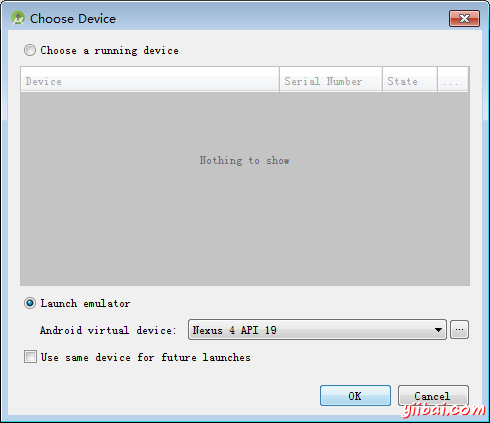
选择移动设备作为一个选项,然后检查移动设备将显示如下界面:
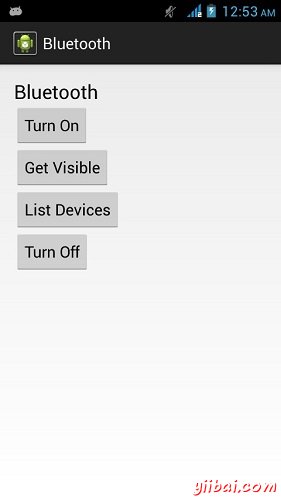
现在选择打开开启蓝牙。但是当选择它,蓝牙将不会被打开。事实上它会询问许可,以启用蓝牙。
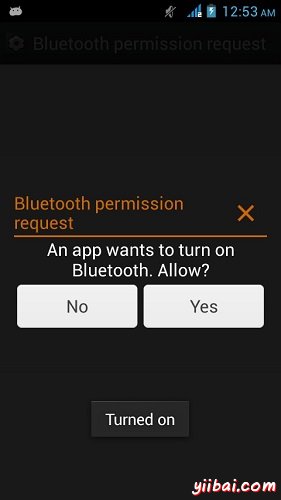
现在,只需要选择设置可见按钮来打开视图。下面的屏幕会出现要求许可才能打开发现120秒。
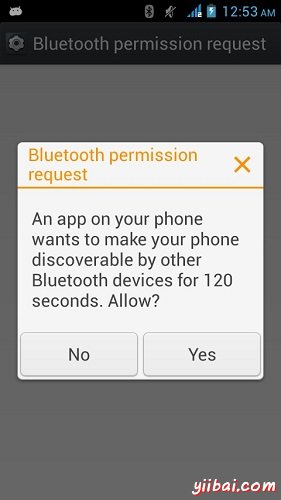
现在,只要选择列表中的设备选项。它会列出倒在列表视图中的配对设备。就我而言,只有一个配对设备。它如下所示。
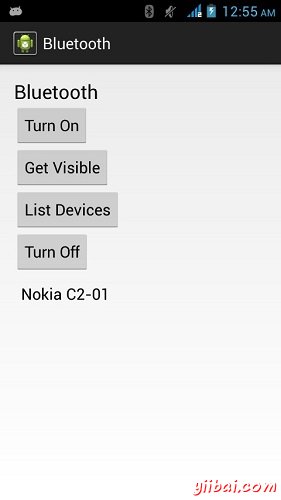
现在,只需选择关闭按钮来关闭蓝牙。当关掉蓝牙指示成功切换关闭蓝牙会出现以下消息。
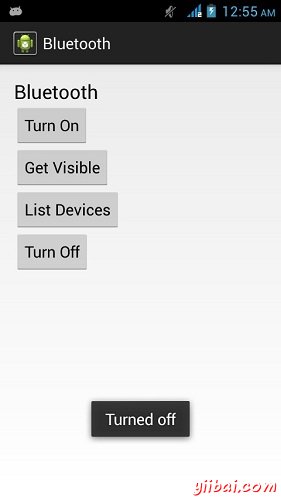
|
